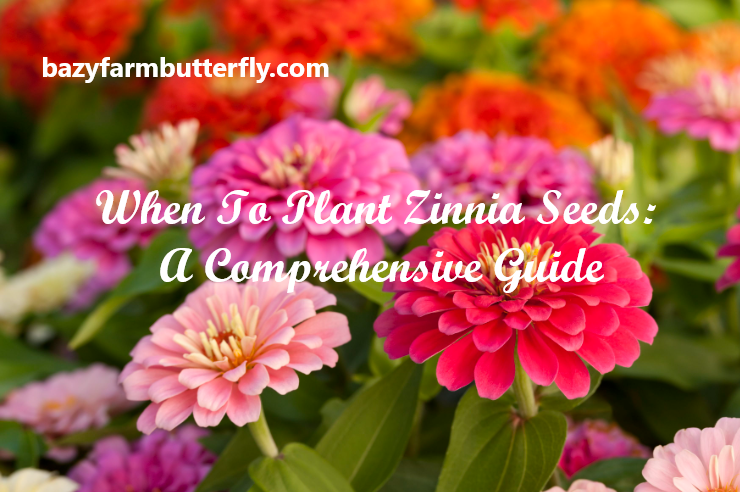When to plant zinnia seeds? If you’re planning to grow zinnias in your garden, one of the most important things to know is when to plant zinnia seeds. Zinnias are a popular annual flower that is easy to grow and come in a variety of colors and sizes. In this article, Bazy Farm will discuss everything you need to know about planting zinnia seeds, including the best time to plant them, how to plant them, and more.
What Are Zinnias?

Zinnias are a type of flowering plant that belongs to the family Asteraceae. They are native to North and South America and are widely cultivated as garden ornamentals. Zinnias come in a variety of colors, from red and yellow to pink and purple, and are known for their bright, showy blooms.
Why Plant Zinnia Seeds?
Before we delve into when to plant zinnia seeds, let’s take a look at why you should plant them in the first place. Here are some reasons why zinnias are a great addition to your garden:
- They are easy to grow and maintain.
- They come in a wide variety of colors and sizes.
- They attract pollinators like bees and butterflies to your garden.
- They bloom all summer long, providing long-lasting beauty to your garden.
- They make great cut flowers for bouquets and arrangements.
Now that we know why zinnias are a great addition to any garden, let’s move on to the main topic of when to plant them.
Factors to Consider When Planting Zinnia Seeds

Temperature
Zinnias require warm soil and air temperatures to germinate and grow well. It is best to wait until spring when temperatures have risen to at least 70 degrees Fahrenheit before planting zinnia seeds directly into the ground. If you live in a colder climate, you can start the seeds indoors about 30 to 40 days before the last frost date.
Soil
Zinnias prefer fertile, well-draining soil. It is important to prepare the soil before planting by removing any weeds, rocks, or debris and adding compost or other organic matter to improve soil quality. Raking the soil well before planting can also help create a good seedbed].
Light
Zinnias require full sun to thrive and produce the most blooms. Choose a site in your garden that receives at least 6 hours of direct sunlight per day.
When to Plant Zinnia Seeds

There are several factors to consider when deciding when to plant zinnia seeds, including the climate and the type of zinnia seeds you have. Here are some guidelines to follow:
Determine Your Climate Zone
The first step in determining when to plant zinnia seeds is to determine your climate zone. This will help you figure out the best time to plant based on your location. Zinnias prefer warm weather, so they should be planted after the last frost.
Planting Zinnias in Warm Weather
If you live in a warmer climate, zinnia seeds can be planted as soon as the weather has warmed in May or June. Choose a site in full sun that has fertile, well-drained soil and rake it well before planting.
Starting Zinnia Seeds Indoors
Start seeds in peat and seed starting mix pots about six weeks prior to the last frost if you want to jumpstart the growing season for some early spring color. You may just plant the entire container in the ground once the soil has warmed up sufficiently for zinnia-stain Proper Soil Conditions.
Planting Zinnias After Frost
If you live in an area with colder weather, wait until after frost before you start planting zinnia seeds. Genuinely, sow them in the spring at the same time you sow carrots. About 30 to 40 days before to the last day of frost, you can also begin sowing the seed indoors. If you want your zinnias to bloom sooner, do this action.
Other Factors to Consider
Other factors to consider when planting zinnia seeds include the soil conditions, sunlight exposure, and watering needs of the plant. Zinnias prefer well-draining soil and plenty of sunlight. They also need to be watered frequently, particularly during dry spells.
Tips for Successful Zinnia Growth
Watering
Zinnias require regular watering to thrive, especially during hot, dry weather. Water the plants deeply and regularly to keep the soil moist but not waterlogged. Avoid overhead watering, as wet leaves can lead to disease.
Fertilizing
Zinnias are heavy feeders and require regular fertilization to promote healthy growth and blooming. During the growing season, apply a balanced, water-soluble fertilizer every two weeks.
Deadheading
Removing spent blooms can encourage zinnias to produce more flowers. Deadheading also helps prevent the plant from becoming leggy and promotes bushier growth.
How to Plant Zinnia Seeds
Direct Seeding
The easiest way to start zinnias is to plant them directly into their final beds outdoors. Plant the seeds about 1/4 inch deep in well-draining soil, spaced as much as your chosen variety needs. Water the soil gently but thoroughly after planting to ensure that the seeds are moistened.
>>> Read more: How to plant zinnia seeds
Transplanting Seedlings
If you prefer to start zinnias indoors, you can transplant the seedlings after they have grown a few inches tall. However, zinnias have delicate roots and do not like to be disturbed, so it is important to handle them gently. When transplanting, dig a hole deep enough to accommodate the entire root ball, and be careful not to break or damage the roots.
Conclusion
In conclusion, zinnias are beautiful and easy-to-grow flowering plants that can add color and interest to any garden. By considering factors such as temperature, soil, and light, and following proper planting and care techniques, you can ensure successful zinnia growth and bloom.

